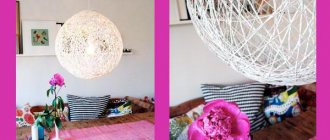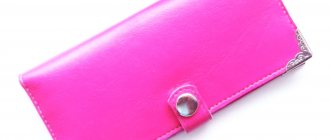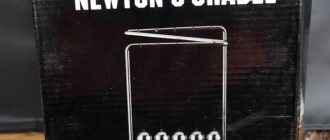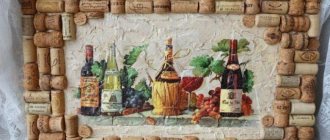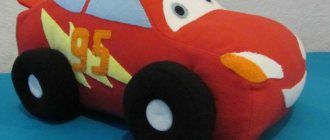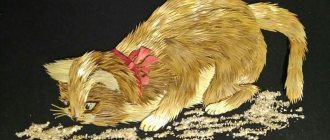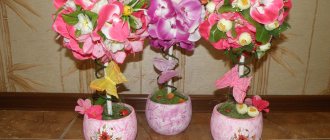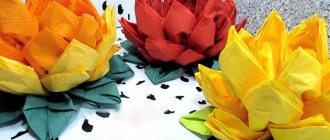Original chandeliers with an unusual design are now in fashion. Such a decorative detail can become a special element of the harmonious appearance of any room. Many manufacturers offer to purchase original and bright solutions in various styles, however, you can make an excellent lampshade yourself from quite familiar scrap materials.
Today we will figure out how to make an unusual rope chandelier .
Necessary materials for making a chandelier with your own hands:
- clothesline;
- It is better that it is thicker;
- glue: regular PVA and for decoupage, for example, Mod Podge;
- white spray paint;
- wooden plank;
- scotch;
- round lampshade as a base.
In addition, we need a small ball or ball. A simple inflatable beach volleyball ball will do.
The rope should be about 10 m, it is best to use light shades, in particular white. Also, make sure that the PVA glue you use is thick enough.
We also need a strip or plinth with a smooth recess in order to lay the rope there and give it a stylish wave-like shape. After placing the rope in such a retainer, it must be thoroughly coated with glue and dried for 24 hours until the new form is completely fixed.
Now we take our ball and glue it tightly with pieces of electrical tape or adhesive tape. This is necessary so that the rope does not subsequently lose its even twisted shape. Next, we lay the rope evenly over the round surface, slowly moving along a correctly spiral-shaped path. At the same time, we thickly coat the entire structure with our decoupage glue.
We separate the base-shade from the old chandelier. It should more or less match the style of the intended product.
We paint with white spray paint, spraying it evenly over the surface. We should get a frozen hemisphere of a rich white shade.
We assemble the entire product, connecting the base with our hemisphere.
Such a seemingly inconspicuous material like clothesline can turn out to be a chic option for decorative finishing in many other corners of your apartment. So, as you can see, making such an interesting little thing is quite simple, the main thing is to offer a little effort and skill. A beautiful DIY rope chandelier will be an excellent addition to the interior of any room.
In principle, this way you can decorate not only a chandelier, but also a floor lamp, sconce, table lamp or just a decorative item. The lampshade is perfect for a minimalist and rustic style.
All you need is a balloon (if you want an even round shape, an inflatable ball from the sporting goods section is better), a roll of natural hemp twine (at least 100 meters, depending on the diameter of the ball), a permanent marker, disposable gloves, quick-drying glue and scissors.
Advantages of using a thread lampshade
The interweaving threads of the lampshade will create fancy shadows on the walls, drawing intricate laces that will tremble and sway from the slightest draft in the room. Warm, calm light will sprinkle small rays and draw smiles on the wallpaper and ceiling. Lightness and weightlessness, the measured swaying of the lamp will give peace and quiet joy, which is akin to light meditation on the shore of a warm, gentle sea.
Look through your yarn baskets and find threads that match the color and texture to match the color scheme of the room. Then your creation will live in a single ensemble with a common atmosphere, and complement and decorate the interior of the room.
Thread to thread, circle by circle... And before your eyes a unique pattern of colored yarn will be born. And you won’t be able to create a second work like this; each thread lampshade will be special and unique. Turn on the music, free your mind from unpleasant thoughts and immerse yourself in the meditative process...
What kind of interior would this lamp be suitable for?
A chandelier made of threads can harmoniously fit into any interior of the room. It all depends on the design and material:
- for the corridor, kitchen, the ideal option is made of dense threads or strong rope;
- for a nursery and a high-tech room - made of thin threads in the shape of a ball;
- for the bedroom, kitchen, living room - from knitted napkins.
The chandelier is good for Provence and country style. In this case, it is worth choosing threads of white, brown, yellow, orange, and beige colors. You can decorate the lampshade with butterflies, birds, fruits, leaves - made of thick paper, plastic bottles, foil. Then this lamp will perfectly decorate a country house.
Tools and materials for work
In every home you can find almost all the elements to create such a lampshade:
- For the basic shape of the chandelier, you can choose an inflatable balloon, a small ball or the frame of an old chandelier or sconce, you can also use an embroidery hoop.
- Cotton, linen, wool or mixed threads. White balls made of cotton threads look ideal, this is a win-win option. Choose yarn that matches the main colors of the walls and wallpaper, maybe 2-3 shades darker or lighter. And if you or your children love holidays, then choose bright, rich colors in contrast to the main color.
- Glue (PVA, transparent stationery) and varnish for covering a ball of thread.
- For the electrical part you need a cartridge and a stranded wire 15-20 cm long
- If you want to make a wall sconce, then to work you will need a stand for the sphere, a wire with a plug and a light switch. Consider the lampshade option before starting work.
- If you choose to make a pendant from several small balls, then purchase or take out a garland with light bulbs from the New Year's box.
What will you need to make a lamp?
Materials you will need for your DIY lamp:
To create a lamp you will need an inflatable ball and a rope.
- waxed or hemp rope (the main thing is that it consists of natural material), size 15-20 m;
- inflatable ball (you can use a beach ball, a fitness ball);
- transparent glue (so that it is not visible on the ball);
- glue container;
- latex gloves;
- newspaper;
- marker or felt-tip pen;
- ball release needle or pin;
- latex paint.
When you have collected everything you need, you can start working. It is better to work with rubber gloves so as not to get your hands dirty with glue, as it is difficult to wash off.
DIY thread chandelier
- We inflate the balloon to the size we need and tie it well with thread. If it deflates, the shape of the lampshade will be sloppy and loose.
- Apply Vaseline or baby cream to the ball. This is done so that the adhesive threads come away from the ball well at the end of the work.
- On the top of the ball (where the tie is), carefully draw a circle with a felt-tip pen with a diameter of 5-7 cm, depending on the size of the lampshade. You can put the glass down and circle it.
- We need to soak the entire thread with glue. To do this, take a plastic cup and make two holes near the base, corresponding to the thickness of the yarn. Pull the end of the thread through the holes.
- Pour glue into a glass. We attach a bobbin of wool or a spool of thread to a pin so that the ball does not roll away during work. Carefully pull the yarn through the cup of glue.
- The creative part begins. We wind the thread evenly around the ball, trying not to make large gaps (unless this is part of your idea). Leave the chuck surface open. Let the ball dry for several hours. You can hang the lampshade by a thread, or put it in a pan so that the shape does not wrinkle.
- After the ball is dry, pierce it with a needle, or release the air from it and remove it from the inner sphere.
If desired, you can coat the lampshade with furniture varnish, this will give it rigidity and shine.
Workflow Stages
If you think that the work is difficult and you need to have certain skills, then you are very mistaken. The option I described is available to any person, even if he has never engaged in such activities . The main thing is to have everything you need at hand and spend an hour of your time on the work.
Required materials and tools
Let's figure out what we need for work. The list is approximate, and you can change individual elements in it, the main thing is to understand what will be used and for what:
Everything you need must be collected in advance
| Materials and tools | Description |
| Lampshade holder | In our case, this is a part of the finished product, which has a mount to the ceiling, as well as a socket with a washer for attaching the lampshade. This option is good because it can be raised and lowered, but you can purchase a piece of wire with a socket on which there will be a mounting system |
| Lampshade mold | We used a plastic bowl of the shape and configuration we needed, you can choose something to suit your taste. There are no special requirements, the main thing is that it is convenient for you to work, and the shape is suitable for the manufacture of the structure |
| Twine | In our case, this is a jute option, which costs little and is sold in hardware stores and outlets selling handicrafts. But you can use other options, it all depends on the plan and the availability of this or that material. |
| PVA glue | Its quantity depends on the size of the structure; the main thing is to use a high-quality composition, which, when dried, will give the structure strength. The glue needs to be poured into a container, so you also need to have it on hand |
| Cling film and scissors | With the help of film we will protect our form from glue and will be able to remove the finished product later. Scissors are needed for cutting film and cord; if desired, you can also use a stationery knife, this is a matter of convenience |
Of all of the above, pay special attention to the quality of the glue, since it determines how reliable the product will be.
How a lampshade is made
Now let’s figure out the sequence in which the work is performed:
- First of all, take our container, which will serve as a mold, place it bottom up and cover it with cling film. The film should cover all surfaces to prevent glue from getting on them. There is no particular need for accuracy here, the main thing is to press the material tightly over the entire area;
The film prevents the lampshade from sticking to the bowl
- Next, you need to pour the glue into a container of a suitable size, since we will soak the blanks for our lampshade in it;
- As for the blanks, pieces of twine 40-50 cm long are cut for them, their quantity depends on the size of the structure, but it is important to remember one simple truth: the more ropes there are on the surface, the better the product will look;
- Another important nuance - you need to unscrew the fastening washer from the cartridge, place it in the middle of the bowl, in the place where the structure will be attached, and use a pen or felt-tip pen to draw the diameter so as not to glue the rope where the hole should be;
Circle the fastener to leave a hole for it in the structure
- The ropes must be soaked in PVA glue, they must be saturated with the composition, this will allow you to fasten them as necessary. The twine prepared in this way acquires very high flexibility, which is also important;
- The gluing is done in a chaotic manner, the more bends and weaves you get, the better the final result will look. You simply take one piece of rope at a time and press it against the surface, trying to create attractive bends. Naturally, it is not recommended to enter the marked hole, since you will need to subsequently assemble the structure;
The rope adheres very well to cling film
- The work is carried out until the lampshade is ready; if during the process you realized that there are too few ropes, it’s okay - cut more and add. It is important that the ends do not stick out anywhere; it is best to wrap them around the bends so that they are not visible at all;
Work continues until the result satisfies you
- The product must be left until the glue has completely dried; most often, gluing the twine is done on one day, and the rest of the work on the second. Just touch the lampshade: if you feel moisture in some areas, it is better to leave it to dry for some more time;
- When the element has dried, you need to remove the bowl from the middle; this is easy to do. Next, you need to separate the film from the twine; it comes off quite easily; it is important to carry out this work carefully so as not to damage the structure. If necessary, you can cut off heavily stuck pieces with scissors;
After the glue has dried, removing the container and film is not difficult.
- Then you need to attach the part with the socket; to do this, the fastening element is unscrewed from it, and the holder is inserted into the lampshade; if it does not fit, then you can cut off the excess parts with scissors, everything is quite simple. The cartridge is clamped tightly so that the structure is reliable;
Screw the fasteners tightly so that the lampshade does not dangle
- The finished product is connected to the network, after which it can be used. Such designs are suitable for a wide variety of interiors and will cost you pennies.
This lampshade looks very original
Assembling the electrical part:
If you have an old lamp, then the task is simplified: take all the components and parts from it. But if it is not there, our instructions will help.
Let's prepare a set of materials:
- socket for an electric lamp;
- cartridge holder;
- the wire.
You can assemble such a structure yourself.
- We cut a hole in the center of the plastic cover to the size of the cartridge. It is advisable to take a cartridge with external threads and clamping rings. Secure the rings at the top and bottom of the lid.
- We attach the cover with the cartridge to the lampshade.
- We connect the wire from the cartridge contacts to the ceiling terminal.
If you want to make a sconce, table lamp or night light, then connect the wire through the switch to the plug for the electrical outlet.
Conclusion
Making unusual things is much easier than it seems. You don’t need expensive materials and complex equipment, the main thing is to have a desire to create and devote your time to it. Watch the video, in it we showed the process clearly so that you can understand everything down to the smallest nuances.
Did you like the article? Subscribe to our Yandex.Zen channel
October 6, 2016
Accessories, Design
If you want to express gratitude, add a clarification or objection, or ask the author something, add a comment or say thank you!
Lampshade made of threads on an old chandelier frame
An old lampshade will do the job. It is necessary to remove the old decorative material, correct the shape of the frame if it is deformed, and wind threads of the desired color, thickness and quality.
To make your work look neat, wind the threads evenly covering the area. You can place the yarn randomly, or you can lay the turns diagonally or perpendicular to each other. Thanks to this, beautiful intricate patterns will be created, and they, in turn, will cast fancy shadows on the walls and ceiling.
You don’t have to use glue in this option, but after finishing the work you will need to apply varnish to all layers of thread. Next, dry the frame well for 8 hours.
How to make a frame for a lampshade
In old table lamps, the frame usually does not undergo such irreversible changes and deformations that it cannot be used to create a new lampshade. But a person may not be satisfied with its shape or size, and then he has to make a new one with his own hands. The question is: how and from what?
The easiest way is to use aluminum or steel wire of such a cross-section that it holds its shape well. The skeleton of the future lampshade is formed from it.
| Stages of work | Description |
Stage 1 | We cut out templates from cardboard for all lampshade diameters. It can be one if the shape is assumed to be cylindrical, two if it is cone-shaped, three or more if it is complex. We cut off pieces of wire and form circles from it according to the template. Twist the ends tightly, using pliers if necessary. |
Stage 2 | We decide on the height of the lampshade and the number of vertical jumpers. We cut the wire for them 8-10 centimeters longer than needed. |
Stage 3 | We bend the excess ends of the wire perpendicularly and wrap them around the upper and lower circle. We additionally fix all joints and mask them with electrical tape. You can wrap it around the entire frame. |
Stage 4 | If the lamp does not have a stop for the socket, we modify the frame. Why do we first make a wire ring with a diameter slightly larger than the diameter of the cartridge and connect it to the frame posts with horizontal jumpers. |
The frame can also be assembled by welding or soldering. When soldering, it is better to use soldering acid instead of rosin.
Advice. Ready-made items can also become the basis for a lampshade. For example, plastic or metal wire waste baskets, wicker vases or plastic bottles. They just need to cut a hole for the cartridge.
Useful tips for choosing lamps
Be careful when choosing lamps for lampshades made of threads, since glue, varnish, and threads are flammable materials. They should be kept away from sources of high temperatures and open flames. Therefore, discard the old model incandescent lamp and opt for a fluorescent or LED lamp. They heat up slightly and consume less electricity, and their lighting intensity is higher.
The retail chain has a large selection of LED lamps, both in size and current consumption. A 9 W lamp produces the same light intensity as a 60 W incandescent lamp. They cost more, but with long-term use the savings on energy consumption are obvious. And the most important advantage is that the risk of fire is reduced.
Very often our taste preferences do not find options when choosing chandeliers, lamps or sconces in stores. In this case, you can create an interesting interior object with your own hands, using the proposed ideas and tips.
Method 2. Creating a masterpiece - you need to try!
You can get excellent kitchen lighting if you make your own lamp from beads or fabric. You will get a shabby chic style lamp or a real candelabra chandelier.
For this job you will need:
- An old hoop, garden basket, hanging metal planter, or wire to create a frame;
- Decorative chains;
- Beads, beads, ribbons, strong threads;
- Lamp socket.
The lamp will be a two- or three-level structure of rings located one above the other and connected by chains or wire.
The rings can be taken in different sizes, creating a lampshade in the spirit of a vintage classic, or the same size - this is exactly the type of lighting that is done in the Art Nouveau style.
The base of the lamp is certainly painted, wrapped or decorated, after which they begin to string the beads.
The consumption of beads in this project is as follows:
Bottom part: beads with a diameter of 16 mm, 15 pcs. on a thread;
Upper part: beads with a diameter of 12 mm, 31-32 pcs. on the thread.
Here you can vary the degree of tension and the number of threads.
Advice! The work should be carried out by first hanging the chandelier and inserting a socket into it.
By analogy, you can create a chandelier from artificial fruits for the kitchen. And subdued lighting will be achieved if you use fabric to cover the frame. As a rule, such a lampshade is made for country and Provence styles.
